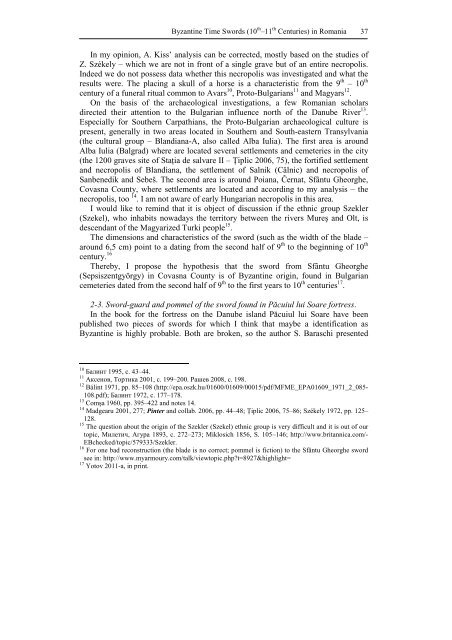Download - Facultatea de Științe Socio-Umane - Universitatea ...
Download - Facultatea de Științe Socio-Umane - Universitatea ...
Download - Facultatea de Științe Socio-Umane - Universitatea ...
Create successful ePaper yourself
Turn your PDF publications into a flip-book with our unique Google optimized e-Paper software.
Byzantine Time Swords (10 th –11 th Centuries) in Romania<br />
In my opinion, A. Kiss’ analysis can be corrected, mostly based on the studies of<br />
Z. Székely – which we are not in front of a single grave but of an entire necropolis.<br />
In<strong>de</strong>ed we do not possess data whether this necropolis was investigated and what the<br />
results were. The placing a skull of a horse is a characteristic from the 9 th – 10 th<br />
century of a funeral ritual common to Avars 10 , Proto-Bulgarians 11 and Magyars 12 .<br />
On the basis of the archaeological investigations, a few Romanian scholars<br />
directed their attention to the Bulgarian influence north of the Danube River 13 .<br />
Especially for Southern Carpathians, the Proto-Bulgarian archaeological culture is<br />
present, generally in two areas located in Southern and South-eastern Transylvania<br />
(the cultural group – Blandiana-A, also called Alba Iulia). The first area is around<br />
Alba Iulia (Balgrad) where are located several settlements and cemeteries in the city<br />
(the 1200 graves site of Staţia <strong>de</strong> salvare II – Ţiplic 2006, 75), the fortified settlement<br />
and necropolis of Blandiana, the settlement of Salnik (Câlnic) and necropolis of<br />
Sanbenedik and Sebeš. The second area is around Poiana, Černat, Sfântu Gheorghe,<br />
Covasna County, where settlements are located and according to my analysis – the<br />
necropolis, too 14 . I am not aware of early Hungarian necropolis in this area.<br />
I would like to remind that it is object of discussion if the ethnic group Szekler<br />
(Szekel), who inhabits nowadays the territory between the rivers Mureş and Olt, is<br />
<strong>de</strong>scendant of the Magyarized Turki people 15 .<br />
The dimensions and characteristics of the sword (such as the width of the bla<strong>de</strong> –<br />
around 6,5 cm) point to a dating from the second half of 9 th to the beginning of 10 th<br />
century. 16<br />
Thereby, I propose the hypothesis that the sword from Sfântu Gheorghe<br />
(Sepsiszentgyörgy) in Covasna County is of Byzantine origin, found in Bulgarian<br />
cemeteries dated from the second half of 9 th to the first years to 10 th centuries 17 .<br />
2-3. Sword-guard and pommel of the sword found in Păcuiul lui Soare fortress.<br />
In the book for the fortress on the Danube island Păcuiul lui Soare have been<br />
published two pieces of swords for which I think that maybe a i<strong>de</strong>ntification as<br />
Byzantine is highly probable. Both are broken, so the author S. Baraschi presented<br />
10 Балинт 1995, с. 43–44.<br />
11 Аксенов, Тортика 2001, с. 199–200. Рашев 2008, с. 198.<br />
12 Bálint 1971, pp. 85–108 (http://epa.oszk.hu/01600/01609/00015/pdf/MFME_EPA01609_1971_2_085-<br />
108.pdf); Балинт 1972, с. 177–178.<br />
13 Comşa 1960, pp. 395–422 and notes 14.<br />
14 Madgearu 2001, 277; Pinter and collab. 2006, pp. 44–48; Ţiplic 2006, 75–86; Székely 1972, pp. 125–<br />
128.<br />
15 The question about the origin of the Szekler (Szekel) ethnic group is very difficult and it is out of our<br />
topic, Милетич, Агура 1893, с. 272–273; Miklosich 1856, S. 105–146; http://www.britannica.com/-<br />
EBchecked/topic/579333/Szekler.<br />
16 For one bad reconstruction (the bla<strong>de</strong> is no correct; pommel is fiction) to the Sfântu Gheorghe sword<br />
see in: http://www.myarmoury.com/talk/viewtopic.php?t=8927&highlight=<br />
17 Yotov 2011-a, in print.<br />
37





